Patologiset faktat
Hahmossa näkyvät mm. seuraavanlaiset jäljet:
1. yhden käden ranteessa on suuri pyöreä pistohaava (alimmainen ranne peittyy päällimmäisen alle).
2. isot pistohaavat jalkapöydässä edessä ja alla ikään kuin ne olisi läpäisty yhdellä piikillä.
3. oikeassa kyljessä (viidennen ja kuudennen kylkiluun välissä) syvä haava, joka on aiheutunut pistosta rintaonteloon. Siitä on vuotanut runsaasti verta.
4. pieniä pistohaavoja otsalla ja eri puolilla päänahkaa.
5. lukuisia pitkittäisiä ja poikittaisia haavoja eri puolilla ruumista, etenkin selkäpuolella. Joidenkin tutkimusten mukaan haavojen muoto vastaa roomalaisen flagrum – ruoskan jälkiä.
6. kasvojen ruhjeita ja turpoamista lyöntien jäljiltä. Nenärusto vääntynyt vasemmalle. Sieraimista ja suupielestä valunut runsaasti verta.
7. oikeanpuoleinen viiksen pää repeytynyt, samoin parta oikealta puolelta ja keskeltä.
8. oikeassa polvessa hiertymä ja vasemmassa suuri ruhjevamma.
9. hiertymiä olkapäillä.
10. kummassakaan jalassa ei merkkejä luiden vahingoittamisesta.









Aiheesta englanniksi:
A Summary of STURP's Conclusions
Editor's Note: After years of exhaustive study and evaluation of the data, STURP issued its Final Report in 1981. The following official summary of their conclusions was distributed at the press conference held after their final meeting in October 1981:
No pigments, paints, dyes or stains have been found on the fibrils. X-ray, fluorescence and microchemistry on the fibrils preclude the possibility of paint being used as a method for creating the image. Ultra Violet and infrared evaluation confirm these studies. Computer image enhancement and analysis by a device known as a VP-8 image analyzer show that the image has unique, three-dimensional information encoded in it. Microchemical evaluation has indicated no evidence of any spices, oils, or any biochemicals known to be produced by the body in life or in death. It is clear that there has been a direct contact of the Shroud with a body, which explains certain features such as scourge marks, as well as the blood. However, while this type of contact might explain some of the features of the torso, it is totally incapable of explaining the image of the face with the high resolution that has been amply demonstrated by photography.
The basic problem from a scientific point of view is that some explanations which might be tenable from a chemical point of view, are precluded by physics. Contrariwise, certain physical explanations which may be attractive are completely precluded by the chemistry. For an adequate explanation for the image of the Shroud, one must have an explanation which is scientifically sound, from a physical, chemical, biological and medical viewpoint. At the present, this type of solution does not appear to be obtainable by the best efforts of the members of the Shroud Team. Furthermore, experiments in physics and chemistry with old linen have failed to reproduce adequately the phenomenon presented by the Shroud of Turin. The scientific concensus is that the image was produced by something which resulted in oxidation, dehydration and conjugation of the polysaccharide structure of the microfibrils of the linen itself. Such changes can be duplicated in the laboratory by certain chemical and physical processes. A similar type of change in linen can be obtained by sulfuric acid or heat. However, there are no chemical or physical methods known which can account for the totality of the image, nor can any combination of physical, chemical, biological or medical circumstances explain the image adequately.
Thus, the answer to the question of how the image was produced or what produced the image remains, now, as it has in the past, a mystery.
We can conclude for now that the Shroud image is that of a real human form of a scourged, crucified man. It is not the product of an artist. The blood stains are composed of hemoglobin and also give a positive test for serum albumin. The image is an ongoing mystery and until further chemical studies are made, perhaps by this group of scientists, or perhaps by some scientists in the future, the problem remains unsolved.
shroudencounter.com/worddocuments/Fact_Sheet.pdf
An autopsy on the Man of the Shroud of Turin:
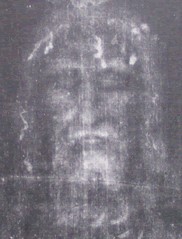
Below: Area of the face that is more swollen, nose region, and blood marks are highlighted.
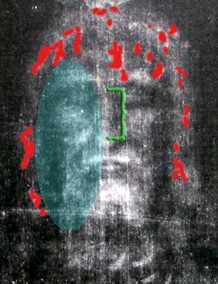
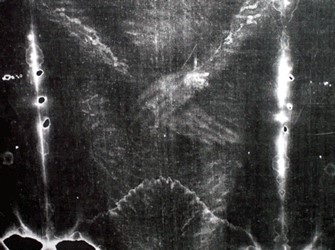
Above: Negative picture of the hand region revealing a positive image.
Below: Blood marks highlighted in red.
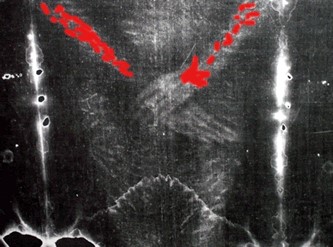
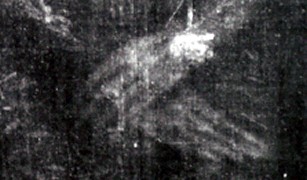
Above: Negative close-up picture of the hand region, revealing a positive image.
Below: The four fingers on each hand are highlighted.
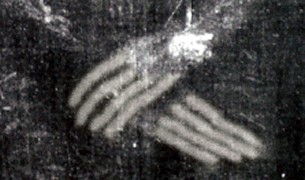
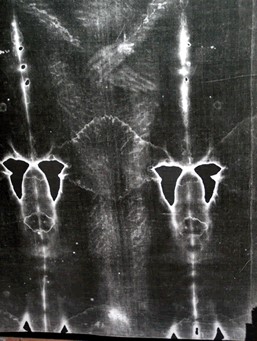
Above: Negative picture of the legs and foot region showing a positive image. The puncture wound is seen on the right foot (the foot on the left in the picture).
In the chest area, there is a large puncture would between the fifth and sixth rib on the right side of the man. This is a post-mortem (after death) wound that has caused a lot of blood flow as well as a watery serum. It appears that something such as a sword, lance, or a spear was thrust into this man's side, piercing his heart.
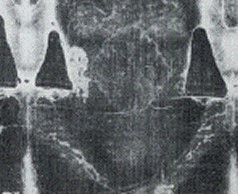
Above: Negative picture of the chest region revealing a positive image.
Below: Side-wound highlighted. Note that the fire damage of 1532 destroyed some of it.
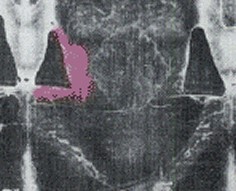
On the back, the doctors noticed that in the head region there are several puncture wounds that seem to indicate something spikey, in a cap-like shape was placed on this man's head.
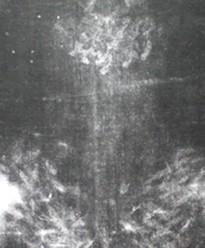
Above: Negative picture of the back of the head, revealing a positive image.
Below: Blood marks on the back of the head are highlighted.
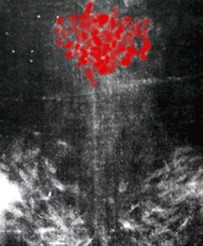
On the back, there is a large bruised area along the shoulder region. It seems that something large, rough, and heavy was placed along this man's back.
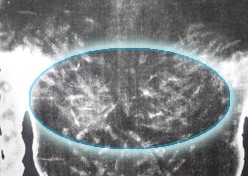
Negative picture of the back showing a positive image: bruised area along the shoulders is highlighted.
Down further, there is a large blood stain from the puncture wound in the side. The blood flow goes across the back.
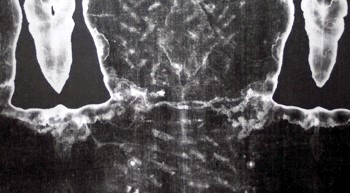
Above: Negative picture revealing a positive image of the mid-back region.
Below: The blood flow along the back, that is a result of the side wound, is highlighted.
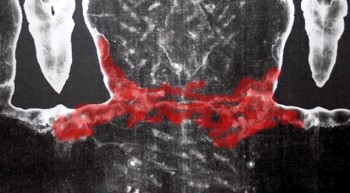

On Left: Full-body Dorsal negative picture of the Shroud revealing a positive image.
On Right: Blood marks from the First-Century Flagrum are highlighted.
Finally, on both of the soles of the feet is a puncture wound.
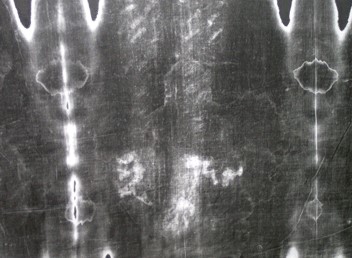
Negative Picture of the soles of the feet revealing a positive image.
The doctors and pathologists concluded that it appears as if this man was beaten, scourged, and crucified in the manner of Jesus of Nazareth.